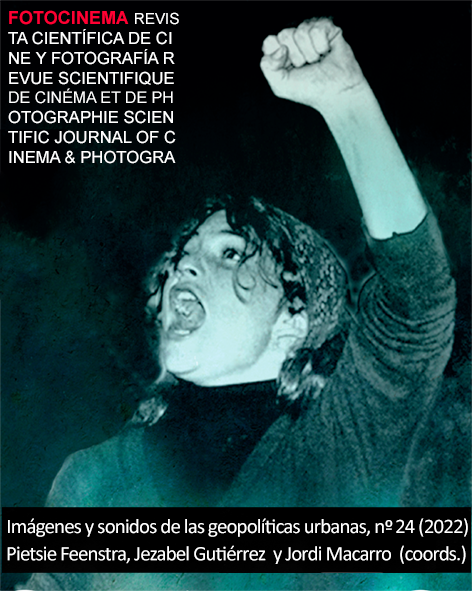Español
DOI:
https://doi.org/10.24310/Fotocinema.2022.vi24.13706Keywords:
Photography, covid-19, communication, Society, PhotojournalismAbstract
The purpose of this research is to identify the impressions and emotions that the photograph generates in people when exposed to an interpretative analysis. For this study, the photograph The firs Embrance by Mads Nissen 2020, winner of the World Press Photo 2021 contest, was analyzed. The research is experimental, using inductive-qualitative methodology. A questionnaire was randomly applied to citizens and the observation technique was used to understand the photographic codes. By nature we believe in photography and understand that any person, regardless of their economic, cultural and social stratum without formal education is able to understand and decode it correctly. The analysis of the reactions of the observers concludes that the photographic act in photojournalism does not end with the publication in the pages of the media, but awakens affective and emotional capacities in the observers.
Downloads
Metrics
Publication Facts
Reviewer profiles N/A
Author statements
Indexed in
-
—
- Academic society
- N/A
- Publisher
- Universidad de Málaga
References
Alcaide, E. (2017). Fotoperiodismo 3.0. España: editorial libros.com
Adatto, K. (2010). La imagen perfecta. España: Cantabria.
Alonso, M. (1995). Fotoperiodismo: formas y códigos. Madrid, España: síntesis.
Barthes, R. (2020). La cámara lúcida. Barcelona, España: Paidós.
Costa, J. (2008). La fotografía creativa. México: Trillas.
De la nuez, I. (2010). Blow up, blow up. Cáceres, España: Periférica.
Flusser, V. (2015). El universo de las imágenes técnicas. Buenos aires, Argentina: Caja negra.
Fontcuberta, J. (2003). Estética fotográfica. (j. Fontcuberta, ed.) Barcelona, España: Gustavo Gili.
Freund, G. (2017). La fotografía como documento social. Barcelona, España: Gustavo Gili.
García, A. (2013). Filosofía de la imagen. (a. García varas, ed.) Enrahonar, p. 101-112.
Horna, K., & Pellizzon, L. (2014). Constelaciones de sentido. Barcelona, España: Sans Soleil.
Mccullin, D. (2013). Slleping with ghost: a life´s work in photography. Barcelona, España: Gustavo Gili.
Marzal, J. (2008). Cómo se lee una fotografía. Madrid, España: Cátedra.
Mellinger, Ch., & Hanson, T. (2016). Estadísticas descriptivas. Londres: Routledge.
Molano, M., & Tagarro, A. (2019). La mirada hipermétrope: el fotoperiodismo en la era de las redes sociales. Fotocinema. Revista Científica De Cine Y Fotografía, 19, 175-188. https://doi.org/10.24310/Fotocinema.2019.v2i19.6651
Momeñe, E. (2009). La visión fotográfica. (c. Guevara, ed.) Madrid, España: Auto – editor.
Redondo, J., & Fernández, J. (2010) . Reconocimiento de fotografías de contenido emocional: efectos de la valencia cuando se controla el arousal. Revista de metodología y psicología experimental. Vol. 31. N°1, 65-86. Disponible en: https://bit.ly/399qpFF
Sandoval, C. (2002). Investigación cualitativa. Programa de especialización en teoría, métodos y técnicas de investigación social. Arfo editores.
Salked, R. (2014). Cómo leer una fotografía. Barcelona, España: Gustavo Gili.
Sampieri, R., Fernández, C., & Baptista P. (2014). Metodología de la investigación. México: Mcgraw Hill Education.
Schiavoni, J. (2017). Fotojornalismo: entre o oblíquo e o referencial. Discursos fotográficos. 13(22), 169-189. Doi10.5433/1984-7939.2017v13n22p169.
Silva, V. (2016). La desilusión de la imagen. Barcelona, España: Gedisa.
Sontag, S. (2014). Sobre la fotografía. Barcelona, España: Debolsillo.
Soulages, F. (2015). Estética de la fotografía. Buenos Aires, Argentina: La marca.
Vicente, P. (2009). Instantáneas de la teoría de la fotografía. Tarragona, España: Arola editors.
World press photo foundation. About us. Disponible en: https://www.worldpressphoto.org/about-us/37373.
Sánchez, F. (2018). Fotografía de prensa. Del simulacro a la posverdad en la era digital. Index.comunicación, 8(1), 197-224
Downloads
Published
How to Cite
Issue
Section
License
All contents published in Fotocinema Revista científica de cine y fotografía are protected under the Creative Commons Attribution-NonCommercial-ShareAlike 4.0 International (CC BY-NC-SA 4.0) license. All about this license is available in the following link: <http://creativecommons.org/licenses/by-nc-sa/4.0>
Users can copy, use, redistribute, share and exhibit publicly as long as:
- The original source and authorship of the material are cited (Journal, Publisher and URL of the work).
- It is not used for comercial purposes.
- The existence of the license and its especifications are mentioned.
There are two sets of authors’ rights: moral and property rights. Moral rights are perpetual prerogatives, unrenounceable, not-transferable, unalienable, imprescriptible and inembargable. According to authors’ rights legislation, Fotocinema. Revista científica de cine y fotografía recognizes and respects authors moral rights, as well as the ownership of property rights, which will be transferred to University of Malaga in open access. The property rights are referred to the benefits that are gained by the use or the dissemination of works. Fotocinema. Revista científica de cine y fotografía is published in an open access form and it is exclusively licenced by any means for doing or authorising distribution, dissemination, reproduction, , adaptation, translation or arrangement of works.
Authors are responsable for obtaining the necessary permission to use copyrighted images.














13.png)



